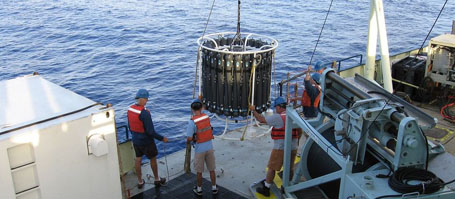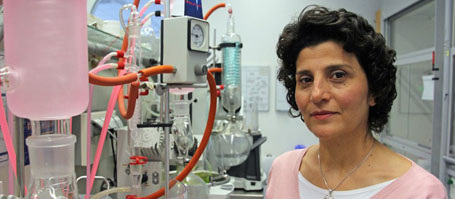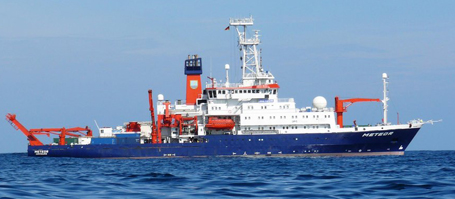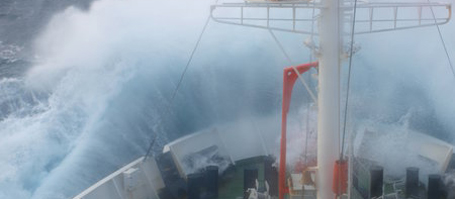For the past seven years, the international research program GEOTRACES has been investigating the sources, sinks and distributions of trace elements and their isotopes. A large data gap in the southern Atlantic is now to be closed by an expedition of the German research vessel METEOR under the leadership of the GEOMAR Helmholtz Centre for Ocean Research Kiel, Germany.
Nutrition is not a typical association when one thinks about copper, manganese or cadmium. On the contrary, cadmium can be toxic to humans and marine organisms at enhanced concentrations. Nevertheless, these trace elements together with others such as nickel, zinc or iron form important micronutrients for phytoplankton in the ocean. This plankton constitutes the first step of the marine food chain, which via fish and other sea food ultimately reaches us humans. In addition, phytoplankton takes up large amounts of carbon dioxide via photosynthesis and thus plays an important role for the Earth’s climate system.
Despite the importance of trace elements, there have been no reliable and globally comparable data on their distribution and origins until recently. Since 2008 a series of expeditions have been undertaken in the framework of the international GEOTRACES programme and have closed some of these gaps of knowledge. On 21 November another GEOTRACES cruise (GA08) will start into the southeastern Atlantic with the German research vessel METEOR. Chief scientists are Prof. Dr. Martin Frank and Prof. Dr. Eric Achterberg, both from GEOMAR Helmholtz Centre for Ocean Research Kiel.
The Cruise will be 8500 km long and after leaving the harbour in Walvis Bay, Namibia will first head northwards along the southwest African coast, where elemental inputs from the continents including dust from the Namibian Desert and the large Congo river will be the focus of the investigations. After passing the mouth of the Congo river the cruise will turn west until the Zero Meridian and then head south again in the open southeast Atlantic to 30°S. From there the cruise will turn again back to Walvis Bay, which will be the final destination of the cruise after Christmas. There are 28 scientists on board from Kiel, Bremen, the United Kingdom, and Angola, who will measure the trace metal concentrations up to a water depth of 5000 metres. It is planned to collect about 15000 litres of water. „The main challenge is to cleanly sample the extremely low trace metal concentrations in seawater. It is not possible to obtain reliable iron concentrations in seawater – which are on the order of some billionths of a gram per litre – if you take the water samples with metal wires and metal sampling devices”, explains Professor Frank.
“To avoid contamination we use purpose-built sample bottles made of plastic, which are fixed on a specifically coated frame. Instead of a steel wire a plastic coated cable to lower this frame to the sampling depths“, Professor Frank explains. RV METEOR doesn’t have such a cable, which is why the expedition will use a mobile winch and cable newly acquired by GEOMAR. A container with clean room laboratory is also taken to sea. There, the scientists will prepare the samples exactly according to the guidelines of the GEOTRACES program. “This will enable contamination-free high precision measurements that we can compare with the results of other measurement campaigns around the globe“, says Professor Achterberg.
Like the data of all other GEOTRACES expeditions the results of the M121 expedition will be transferred to an international data base. There they are accessible to scientists of all disciplines to better understand the geochemical and biological processes in the oceans and to trace oceanic currents or to reconstruct past climatic stages through analyses of the trace elements in the underlying marine sediments. The first data of many elements are already available in 3D on the eGEOTRACES homepage.
Expedition at a glance:
METEOR expedition 121 (GEOTRACES GA08)
Subject: Trace metals in the eastern South Atlantic
Chief Scientist: Prof. Dr. Martin Frank (GEOMAR)
Start: November 21st, 2015, Walvis Bay (Namibia)
End: December 27th, 2015, Walvis Bay (Namibia)
Links:
www.geomar.de GEOMAR Helmholtz Centre for Ocean Research Kiel
www.egeotraces.org/ Digital atlas of trace metals of the GEOTRACES-programm
www.oceanblogs.org/geotracesger The GEOTRACES Germany Blog
Images:
At www.geomar.de/n4097 images are available for download.
Contact:
Jan Steffen (GEOMAR, Communication & Media), Phone: +49 431 600-2811, presse@geomar.de
…



